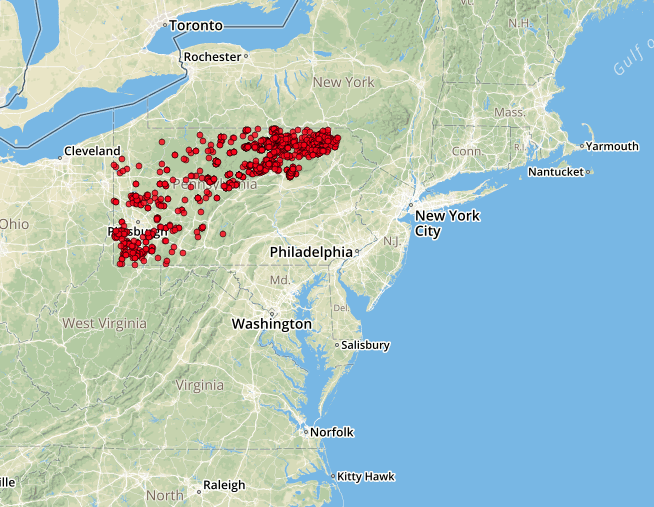Shale energy development, based on new technologies of horizontal drilling with hydraulic fracturing, or “fracking,” helps meet increasing global demand for energy and provides economic benefits. However, fracking also uses large quantities of water and produces toxic chemicals. This group is steering a balanced, constructive approach to shale energy development that avoids water conflicts.
OUR APPROACH: The team investigated where, when, and how spills occur, and what risk they pose to natural resources. This information is compiled in a user-friendly online tool that agencies and governments will be able to use to shape regulations, identify areas that may require additional resources, and strike a balance between conservation and development.

Visualizing Spill Data
The team designed an online interactive spills data visualization tool to provide insight into where, when, and how spills occur. The platform allows users to filter data with metrics such as volume of the spill, spill year, material spilled, and spill pathway, allowing comparisons to be made within and across states. This centralized database allows state regulators and other stakeholders to identify trends in common spill pathways and causes, and pinpoint wells associated with unusually high spill rates, providing decision-makers with important information on where to target efforts for locating and preventing future spills.
Understanding the Risks of Spills
To determine the causes, risk, and frequency of spills, the team analyzed over 30,000 wells in Colorado, New Mexico, North Dakota, and Pennsylvania from 2005-2014. They found that 15% of all wells reported a spill. Other major findings include:
- WHEN: 75% of spills occur within the first 3 years of well life
- WHERE: 50% of spills occurred at storage tanks or flowlines
- WHAT: 69% of materials spilled were crude oil or wastewater
- HOW: 37% of spills were caused mechanical or human errors* (majority (62%) of the causes were unknown)
Additionally, a large subset of spills occurred in very close proximity to streams and in watersheds of high importance to drinking water. As natural gas extraction continues, these findings can be used globally to better understand where to invest in risk-based monitoring and to inform best management practices in regions with developing extraction policies.

“State spill data holds great promise for risk identification and mitigation. As unconventional oil and gas increases, making this data more uniform and accessible will help support state efforts to reduce the risk of a spill occurring.”
– Lauren Patterson, Team Member
This PLoS ONE paper describes the projected and aggregate global spatial patterns of expected urban and agricultural expansion, conventional and unconventional oil and gas, coal, solar, wind, biofuels and mining development in order to inform habitat conservation initiatives.
In this study published in Science of The Total Environment, the team analyzed spill data associated with unconventional wells across several states from 2005 to 2014 and summarized frequency, volumes and spill rates of spilled materials, and evaluated the environmental risk of the spills.
This paper published in Environmental Science and Technology describes the variation in risks, mitigation priorities, and state reporting requirements in states that permit hydraulic fracturing.